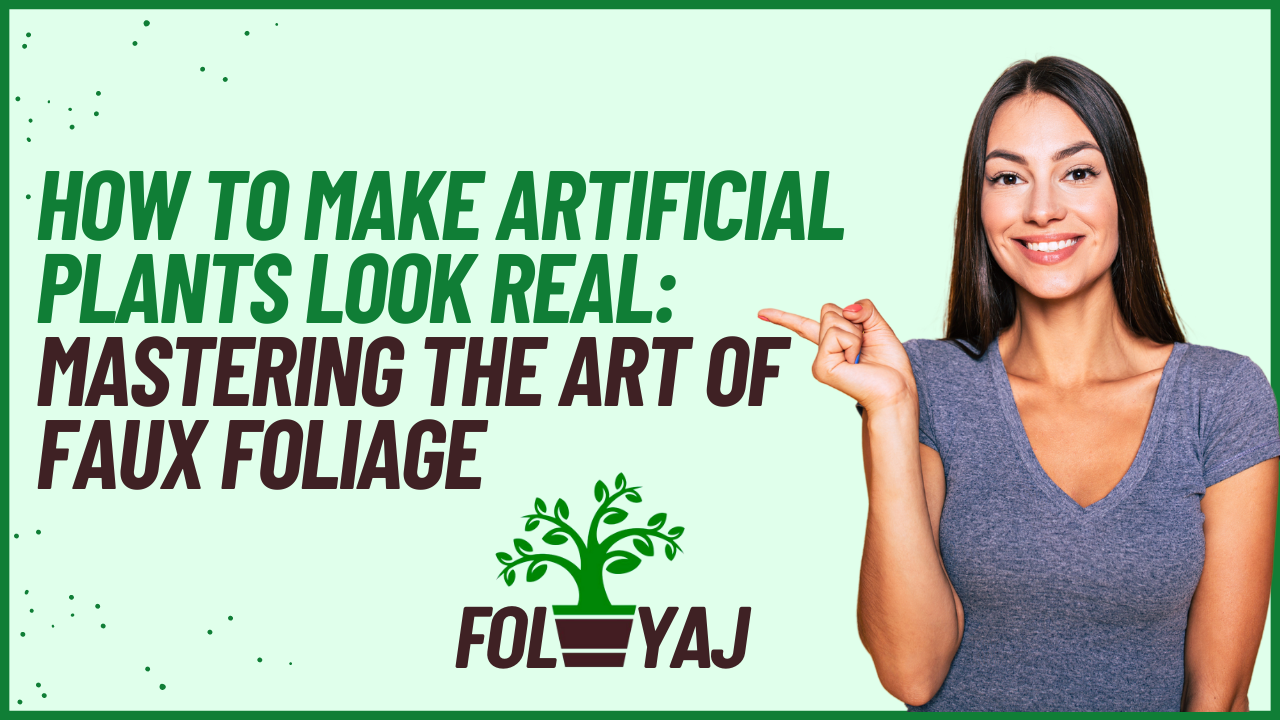
How to Make Artificial Plants Look Real: Mastering the Art of Faux Foliage
In today’s fast-paced world, artificial plants for home decor have become increasingly popular. They offer the beauty of nature without the maintenance demands of live plants. However, the key to successfully incorporating artificial plants into your space lies in making them look as real as possible. This comprehensive guide will walk you through various techniques and tips on how to make artificial plants look real, transforming your home or office into a lush, lifelike oasis.
The Benefits of Artificial Plants
Before diving into the techniques, let’s explore why artificial plants have gained such popularity:
Low Maintenance
Unlike live plants, artificial ones don’t require watering, pruning, or special lighting conditions.
Allergen-Free
For those with allergies, artificial plants provide a green solution without the associated health risks.
Versatility
Artificial plants can thrive in any environment, from low-light spaces to areas with extreme temperatures.
Cost-Effective
While the initial investment might be higher, artificial plants are more economical in the long run as they don’t need ongoing care or replacement.
Choosing the Right Artificial Plants
The first step in making artificial plants look real is selecting high-quality, realistic options. Here are some factors to consider:
Material Quality
Opt for plants made from high-grade materials like silk, polyester, or a blend of fabrics that mimic the texture of real leaves.
Color Variations
Natural plants have subtle color variations. Look for artificial plants with leaves that aren’t uniformly colored but instead feature different shades and tones.
Realistic Stems and Branches
Pay attention to the stems and branches. They should have a natural-looking texture and color, not just plain plastic.
Size and Proportion
Choose plants that are proportionate to your space. Oversized or undersized plants can immediately give away their artificial nature.
Techniques to Enhance Realism
Now that you’ve selected your artificial plants, let’s explore various techniques to make them look even more authentic:
1. Customizing the Arrangement
One of the easiest ways to make artificial plants look real is by customizing their arrangement:
-
Bend and shape the stems and leaves to create a more natural, asymmetrical look.
-
Avoid perfect symmetry, as this rarely occurs in nature.
-
If working with potted plants, adjust the soil line to make it look uneven and natural.
2. Adding Natural Elements
Incorporating natural elements can significantly enhance the realism of your artificial plants:
-
Use real soil or moss on top of the pot to create an authentic look.
-
Add small pebbles or decorative rocks around the base of the plant.
-
For hanging plants, consider using real vines or tendrils alongside the artificial ones.
3. Dust and Clean Regularly
Real plants collect dust, and so should your artificial ones for a more authentic appearance:
-
Use a feather duster or soft cloth to gently remove dust from leaves and stems.
-
For more stubborn dirt, use a mixture of mild soap and water, being careful not to saturate the plant.
4. Strategic Placement
Where you place your artificial plants can greatly impact their perceived authenticity:
-
Position plants in areas where they would naturally grow, considering light conditions.
-
Mix artificial plants with real ones to create a cohesive look.
-
Use artificial plants to fill in gaps where real plants might struggle to thrive.
5. Seasonal Adjustments
To maintain realism throughout the year, consider making seasonal adjustments:
-
Add or remove blooms based on the season.
-
Incorporate seasonal elements like autumn leaves or spring blossoms.
-
Adjust the overall arrangement to reflect how real plants would change with the seasons.
Advanced Techniques for Ultimate Realism
For those looking to take their artificial plant game to the next level, here are some advanced techniques:
1. Custom Potting
Creating custom potting arrangements can significantly enhance the realism of your artificial plants:
-
Use high-quality, realistic-looking pots or planters.
-
Create custom soil mixtures using real potting soil, peat moss, and small pebbles.
-
Add a layer of preserved moss on top for an extra touch of authenticity.
2. Artificial Water Effects
For plants that typically grow in or near water, adding artificial water effects can be a game-changer:
-
Use clear resin to create the illusion of water in vases or pots.
-
Add glass pebbles or marbles to mimic the look of water at the bottom of a clear container.
-
For larger installations, consider using acrylic sheets to create the appearance of water surfaces.
3. Incorporating Faux Roots
Adding visible roots can greatly enhance the realism of your artificial plants:
-
Use thin wire covered with floral tape to create the appearance of aerial roots.
-
For plants in clear containers, add artificial root structures using silicone or resin.
-
Create the illusion of root growth by partially exposing “roots” at the soil surface.
4. Customizing Leaf Texture
While high-quality artificial plants often have realistic leaf textures, you can enhance this further:
-
Use a thin layer of clear nail polish or mod podge to add a subtle sheen to leaves.
-
For succulents or plants with thick leaves, add a touch of dimensional fabric paint to create texture.
-
Gently sand the edges of fabric leaves to create a more natural, slightly imperfect look.
5. Adding Life-Like Imperfections
Real plants aren’t perfect, and adding subtle imperfections can make your artificial plants look more authentic:
-
Use a bit of brown or yellow paint to create the appearance of slight leaf damage or aging.
-
Add small holes to leaves to mimic insect damage (but don’t overdo it).
-
Create slight color variations on stems and branches using dry brushing techniques with acrylic paint.
Maintaining Your Artificial Plants
While artificial plants don’t require the same care as live ones, proper maintenance is key to preserving their realistic appearance:
Regular Cleaning
Dust and clean your artificial plants regularly to maintain their fresh look. Use a soft brush or cloth for dusting, and occasionally wipe down leaves with a damp cloth.
Refreshing and Reshaping
Periodically reshape your plants, adjusting leaves and stems to maintain a natural look. This is especially important for plants in high-traffic areas that may get bumped or moved.
UV Protection
If your artificial plants are exposed to direct sunlight, consider using a UV-protective spray to prevent fading and maintain their vibrant colors.
Seasonal Rotation
Just as you might rotate live plants, consider changing the placement of your artificial plants seasonally. This not only keeps your decor fresh but also prevents uneven fading or wear.
Incorporating Artificial Plants in Different Settings
Artificial plants can enhance various environments when used thoughtfully:
Home Decor
In home settings, use artificial plants to add life to corners, bookshelves, and areas where real plants might struggle. Mix them with other decor elements for a cohesive look.
Office Spaces
Artificial plants can bring a touch of nature to office environments without the need for maintenance. Consider maintaining miniature artificial plants on desks or larger statement pieces in reception areas.
Outdoor Areas
For patios, balconies, or other outdoor spaces, choose UV-resistant artificial plants designed for exterior use. These can provide year-round greenery without the need for watering or protection from harsh weather.
Commercial Spaces
In restaurants, hotels, or retail environments, artificial plants can create inviting atmospheres without the need for constant care. Use them to create green walls, hanging installations, or as part of larger decor themes.
The Future of Artificial Plants
As technology advances, the future of artificial plants looks even more promising:
Improved Materials
Ongoing research in materials science is leading to the development of even more realistic-looking and feeling artificial plants.
Smart Features
Some companies are exploring the integration of smart features into artificial plants, such as air purification or ambient lighting capabilities.
Sustainable Production
There’s a growing focus on creating artificial plants using more sustainable and eco-friendly materials and production methods.
Conclusion
Mastering how to make artificial plants look real is an art that combines careful selection, creative arrangement, and thoughtful maintenance. By following the techniques and tips outlined in this guide, you can create stunning, lifelike displays that bring the beauty of nature into any space without the demands of plant care. Whether you’re decorating a home, office, or commercial space, artificial plants offer a versatile, long-lasting solution for incorporating greenery into your environment. With a little creativity and attention to detail, your artificial plants can become a seamless, beautiful part of your decor, indistinguishable from their living counterparts.


